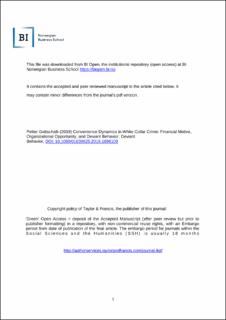| dc.contributor.author | Gottschalk, Petter | |
| dc.date.accessioned | 2020-06-09T10:32:39Z | |
| dc.date.available | 2020-06-09T10:32:39Z | |
| dc.date.created | 2019-11-30T08:03:14Z | |
| dc.date.issued | 2019 | |
| dc.identifier.citation | Deviant Behavior. 2019, 1-12. | en_US |
| dc.identifier.issn | 0163-9625 | |
| dc.identifier.uri | https://hdl.handle.net/11250/2657337 | |
| dc.description.abstract | System dynamics modeling enables the study of cause-and-effect relationships as well as causal feedback loops. Based on a structural model of white-collar convenience, this article suggests a dynamic model of white-collar convenience as well as a dynamic model of the agency perspective in convenience theory. This article argues that perceived and preferred convenience changes dynamically over time. The offender’s financial motive can become stronger or weaker over time. Perceived organizational opportunity can become larger or smaller over time. The offender’s personal willingness for deviant behavior can become higher or lower over time. In addition, motive, opportunity, and willingness can dynamically influence each other. | en_US |
| dc.language.iso | eng | en_US |
| dc.publisher | Taylor and Francis | en_US |
| dc.title | Convenience Dynamics in White-Collar Crime: Financial Motive, Organizational Opportunity and Deviant Behavior | en_US |
| dc.type | Journal article | en_US |
| dc.type | Peer reviewed | en_US |
| dc.description.version | acceptedVersion | en_US |
| dc.source.pagenumber | 1-12 | en_US |
| dc.source.journal | Deviant Behavior | en_US |
| dc.identifier.doi | 10.1080/01639625.2019.1698109 | |
| dc.identifier.cristin | 1754898 | |
| cristin.unitcode | 158,4,0,0 | |
| cristin.unitname | Institutt for ledelse og organisasjon | |
| cristin.ispublished | true | |
| cristin.fulltext | postprint | |
| cristin.qualitycode | 1 | |
